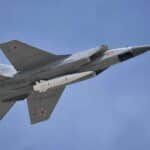Determining the truth about U.S. missile defense
By Hugh Gusterson | September 23, 2007
Among the many reasons for the deterioration in relations between the United States and Russia is the Bush administration’s recent announcement of plans to deploy components of a missile defense system in the Czech Republic and Poland. While the administration said the system is designed to target future Iranian missiles, the Russians objected that it would also hold their nuclear missiles at risk. They suggested that the United States use a radar in Azerbaijan, which would be unable to track Russian missiles, in lieu of the proposed facility in the Czech Republic. When the United States rejected this offer, the Russians retaliated by suspending compliance with the Treaty on Conventional Armed Forces in Europe.
Senior U.S. officials have denied that the proposed system would pose a threat to Russia’s nuclear forces. The New York Times quoted Gen. Henry Obering, director of the Missile Defense Agency, as saying that because Russia is too close to Poland, U.S. interceptors destined for Poland “cannot physically catch the Russian ICBMs even if we were trying to target those missiles.” Obering has also given a briefing to this effect to NATO allies.
Meanwhile Secretary of State Condoleezza Rice dismissed Russia’s concerns as a holdover from Cold-War thinking, saying “the idea that somehow 10 interceptors and a few radars in Eastern Europe are going to threaten the Soviet strategic deterrent is purely ludicrous, and everybody knows it.” (For more, see Pavel Podvig’s “The U.S. and Russia’s ‘ludicrous’ missile defense rhetoric.”) If her use of the word “Soviet” suggested some ingrained Cold-War thinking on her part, too, more seriously the comments made by Rice and Obering raise questions about their technical understanding of the system they are promoting or about their honesty.
Enter Ted Postol. Postol, an MIT professor, is one of the leading independent technical analysts in the arms control community. He established himself as a force to be reckoned with after the first Gulf War when he showed that the Patriot missile shot down fewer than 10 percent of the Scud missiles it engaged–and maybe as few as zero. Almost single-handedly, with dogged persistence, Postol forced the Pentagon to back down from its initial claim that the Patriot shot down more than 96 percent of the Scuds.
More recently, Postol has publicized technical flaws in the Missile Defense Agency’s testing program. He showed that prototype interceptors were only able to discriminate dummy warheads from decoys in one test because the test was rigged to enable them to do so. While he was at it, he argued that his own university’s Lincoln Lab was complicit with the test-rigging. It’s fair to say that Postol is one of the Missile Defense Agency’s least favorite scientists. (Full disclosure: My wife has worked as part of Postol’s technical security working group, and I was a colleague in Postol’s department at MIT for 14 years.)
In the dog days of August, when Washington is usually deserted, Postol gave a standing-room-only briefing on Capitol Hill on the proposed deployments in Poland and the Czech Republic. As is his custom, he was armed with a thick sheaf of overheads; he spent an hour describing in detail exactly how the proposed system would (and wouldn’t) work.
Postol’s most important revelation was that the proposed system would, in principle, be capable of intercepting missiles launched at the East Coast of the United States from Western Russia. Given the curvature of Earth, he explored how long it would take U.S. radar to acquire and track Russian missiles and showed that interceptors from Poland, closing in at a rate of one kilometer per second, would have plenty of time to catch up with Russian warheads. (He also told us that a slide from General Obering’s briefing to NATO allies has U.S. interceptors traveling at 5 km/second, rather than their actual speed of more than 7 km/second.)
On the other hand, if U.S. interceptors were placed in Turkey rather than Poland, they would be better positioned to destroy Iranian missiles but would be incapable of intercepting Russian missiles on their way to the United States, this goes against claims by the Missile Defense Agency that Poland is the best location for the interceptors.
Postol also pointed out that, in his Presidential National Security Directive 23, George W. Bush clearly sees the deployments to Poland and the Czech Republic as the first phase of a much larger system whose architecture is not yet fully known. In response to Rice’s mockery of Russian concerns about a mere 10 interceptors, he pointed out that the Russians have legitimate concerns that these deployments are “the leading edge” of a much larger system that would pose a more serious threat to their arsenal–especially one smaller in size because of arms control reductions.
What are we to make of all this? Postol expressed concern that General Obering’s briefings have misled NATO allies. I would add that the U.S. public is also being misled. I vividly recall a conversation I had in the late 1990s with a senior adviser to President Bill Clinton. In the context of the 1990s missile defense debate, he told me that White House statements that missile defense would be needed to intercept a North Korean missile were a sort of verbal decoy. “It’s really about China,” he said. “Don’t tell anyone I told you.” So, in the current round of missile defense plans, is Iran a decoy for a system that is “really about” Russia?
I don’t know the answer. But it seems clear that either senior U.S. officials are guilty of bad faith in their pronouncements to allies and to their own citizens, or else they have not mastered the technical details of one of our key national security programs. Either way, democracy is ill-served. If the U.S. public is to reach an informed opinion about a program with profound implications for our diplomacy and our national defense, then we need accurate information about the program’s capabilities. If the proposed system really is aimed at Iran but has the unfortunate side effect of threatening the Russians, we need to discuss that honestly rather than ridiculing the Russians, who we say are no longer our enemies. On the other hand, if these initial deployments really are the start of a bold–many would say foolhardy–initiative to neutralize Russian nuclear weapons, we need to debate the system’s true ambition, not waste our time on fairy tales about Iranian missiles.
Together, we make the world safer.
The Bulletin elevates expert voices above the noise. But as an independent nonprofit organization, our operations depend on the support of readers like you. Help us continue to deliver quality journalism that holds leaders accountable. Your support of our work at any level is important. In return, we promise our coverage will be understandable, influential, vigilant, solution-oriented, and fair-minded. Together we can make a difference.
Topics: Columnists, Missile Defense














